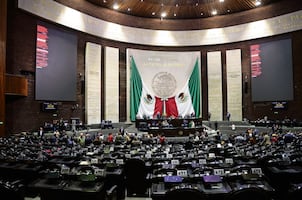Más Información

Alito Moreno afirma que México debe ser aliado de EU ante dictaduras como la de Maduro; "¡Venezuela libre ya!”

Morena va contra “Ley Esposa” en SLP que postula solo mujeres en 2027, señala Alcalde; prepara acción de inconstitucionalidad
Designation of origin
protect the natural and cultural heritage of a country. In turn, they also position the name of that country, in this case, Mexico, as the source of a product or processes with an unrivaled quality.
In Mexico , there are 16 protected designation of origin registered before the Mexican Institute of Industrial Property (IMPI).
The first designation of origin to be granted was for Tequila in 1974 and the last one was given this March for Yahualica, a geographic area comprising 9 municipalities of Jalisco and 2 of Zacatecas, where chile de árbol (Spanish for tree chili pepper) grows – a product that has to undergo 14 stages to be raised.
According to the document "Designation of Origin, Mexican Pride," the IMPI and the Ministry of Economy describe the properties of 14 products but two of them – Yahualica and Grijalva cacao – included in this list, were registered after its publication.
1.- Chiapas amber is a fossilized resin obtained from the guapinol tree, extracted from caves since the Pre-Hispanic era. This type of amber comes in yellow, red, maroon, and transparent hues and sometimes you can find insects or leaves trapped inside it. It is widely used in jewelry and crafts.

(Photo: NOTIMEX)
2.- Morelos rice has an exquisite characteristic due to the climate of the state and this product is even exported to Germany, the United States, and France. The cereal is famous because it doesn't get mushy easily. There are 22 municipalities covered in this designation of origin.

(Photo: NOTIMEX)
3.- Bacanora is a drink from Sonora, distilled from the Agave angustifolia haw and brewing it can take up to 12 years. It can have between 38 to 55 percent of alcohol. There are four types: white, young, reposado, and aged.

(Photo: NOTIMEX)
4.- Chiapas coffee beans are harvested only once a year and is a rich source of antioxidants, known worldwide. Twelve regions of the state grow this bean.

(Photo: NOTIMEX)
5.- Veracruz coffee beans are known for its aroma, body, and flavor. It has to be grown at an elevation of 750 meters or more.

(Photo: NOTIMEX)
6.- Charanda is a liquor which is half sugar cane juice and half molasses, which gives it a sweet flavor like no other. This drink is brewed in Michoacán and 16 municipalities currently have the designation of origin.

(Photo: NOTIMEX)
7.- Habanero chili pepper from the Yucatán península ranked first in the Scoville scale for a very long time. This chili pepper and its derivatives, produced in Campeche, Quintana Roo and Yucatán, are currently protected.

(Photo: NOTIMEX)
8.- Grijalva cacao , toasted and green, is native to 11 municipalities of Tabasco. One of its characteristics is that it grows in domesticated jungles, similar to a tropical jungle, which gives is a unique aroma, consistency, and taste.

(Photo: NOTIMEX)
9.- Ataulfo mango of the Soconuso region in Chiapas has 70% pulp and is exported to Canada and the United States. Thus far, 13 states have its designation of origin.

(Photo: NOTIMEX)
10.- Mezcal is an agave-based drink whose designation of origin includes the states of Durango, Guanajuato, Guerrero, Michoacán, Oaxaca, San Luis Potosí, Puebla, Tamaulipas, and Zacatecas. The brewing process depends on the tradition of each state.

(Photo: NOTIMEX)
11.- Olinalá is a town in Guerrero which as a real treasure: lináloe wood, which is used to manufacture room dividers, boxes, chairs, chairs, and more.

(Photo: NOTIMEX)
12.- Sotol is a drink brewed in 67 municipalities of Chihuahua, 38 of Coahuila, and 38 of Durango.

(Photo: NOTIMEX)
13.- Talavera pottery is usually decorated with animals, landscapes or similar, and you can find it in sculptures, ashtrays, vases, and pots but it is also used as a finishing of construction projects. The key is the clay with which it is made, and its designation of origin protects four municipalities of Puebla and one from Tlaxcala.

(Photo: NOTIMEX)
14.- Tequila is brewed from the A gave tequilana weber , the blue variety, and it's Mexico's most popular designation of origin. Currently, the protection covers the states of Guanajuato, Jalisco, Michoacán, Nayarit, and Tamaulipas.

(Photo: NOTIMEX)
15.- Three-quarters of the total production of Papantla vanilla is exported, as it is considered the best in the world given that ancient Totonac techniques are still used in its production. The states with the designation of origin are Puebla and Veracrúz.

(Photo: NOTIMEX)
16.- Yahualica is the geographical region where this chili pepper is grown, and it has to undergo 14 production stages before it is sold. Jalisco and Zacatecas currently hold its designation of origin.

(Photo: NOTIMEX)
A protected designation of origin grants an added value to the products it covers and it becomes a competitive advantage at an international level while protecting its producers. In Mexico, laws protect the illegal reproduction of any of the items listed.
The World Intelectual Property Organization states there are 28 countries, including Mexico, part of the Lisbon Agreement, which protects designation of origin.
According to Edwin Várguez, lawyer specializing in intellectual property, “when a product is manufactured with certain characteristics which are the result of its place of origin, geographic factors, or even its climate, we have a unique product,” which becomes attractive to consumers.
*With information from the Mexican Institute of Industrial Property
am
Noticias según tus intereses
[Publicidad]
[Publicidad]













